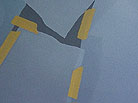Małgorzata Szymankiewicz — ‘Low visibility’ in ‘small space’

We kindly invite you to the opening of the exhibition
on Friday, 16 December at 6 p.m.

‘Inessentials’ — book summary of exhibition cycles The project ‘Inessentials’, which is planned for the whole year, involving artists, designers and the local community in a series of...

Karolina Żyniewicz — ‘Fear of Darkness’ — within the framework of Biennial of Art for Children When Karolina Żyniewicz organises space, she doesn't clearly mark the focal point. The objects are laid out and hung in accordance with her own geometric...

Bartosz Kokosiński — ‘Some pictures do not want to be painted’ Bartosz Kokosiński's most recent paintings look as if something has just wriggled under their surface, stretching the canvas and disfiguring the frames with...

Maciej Nawrot — ‘Days go by in a rush like wild horses from a hill’ I decided to paint it, says Maciek. We can feel that something can happen within certain selected frames, but we are still not sure whether we are in the right...

En eye should be quick and good. There is no time for raising eyebrows, for closing eyelids – it might be too late. In past times one needed time for a journey, for a book, for a catastrophe, for the sunset; all phenomena were measured by length, width and volume. And this was enough. Today objects are only fragments of objects.
—Fernand Leger
For centuries our eyes have been trained to perceive in a certain way. The frame of perspectiva artificialis has stripped vision of randomness and imposed upon it a geometrical order. The Italian word perspicere, meaning deep penetration, indicates a thorough, full, detailed examination, which demands insight, isolation, allocation and organisation, in keeping with the concept of decorum, which tells us what is worth looking at, and how that should be done. History of art does not focus on what has been only glimpsed, fleetingly, suddenly, from the corner of the eye. It does not deal with anything seen through squinted, tired or sore eyes. It is not concerned with staring out through a rain-soaked window, peeping through a keyhole or through leaves.
Dora Maar's face has a double profile because, as Picasso explained, this is how his lover looked when he held her in his arms. Do we need physical intimacy in order to free our eyes? Do we need to examine something from a close distance, so that contours become blurred, leaving only the colour or the pattern?
Małgorzata Szymaniewicz's works are in opposition to the prevailing paradigm of clear vision in art, which presented painters with a challenge of rendering, with mathematical precision, light reflected on objects. Any efforts to portray the fuzzy or the vague were perceived as detrimental to the eye, as well as to rational thinking. In harsh light, just like in darkness and in fog, opposites disappear. It is impossible to estimate the distance, to identify places or objects. When Szymankiewicz paints blurred details that resemble images from the microscope, she rejects visual control over the world. When examining things, she holds back as soon as she gets to their surface. Successive close-ups only result in fuzziness, and the artist seems to be willing to become totally enveloped in it.
On the one hand, Szymankiewicz paints her pictures as if she were outside collecting ragged toys. One moment her attention is attracted by a piece of broken glass, the next by a shiny sweet wrapper, a paper ball or a pebble. The only thing these objects have in common is her affectionate gaze.
On the other hand, objects from her pictures seem chopped up. They are incomplete, broken, chipped. You might think they need care and attention. Yet, as Jean Baudrillard warned in his time, it turns out they begin to play their own game. They enshroud, charm, and suck in the subject who is looking at them. As things are, a subjective viewpoint should be put out to pasture. The viewer should look at what comes from the things themselves, as they continue to grow forever, doubling and exponentiating to the point of obscenity.
Curator: Marta Lisok










